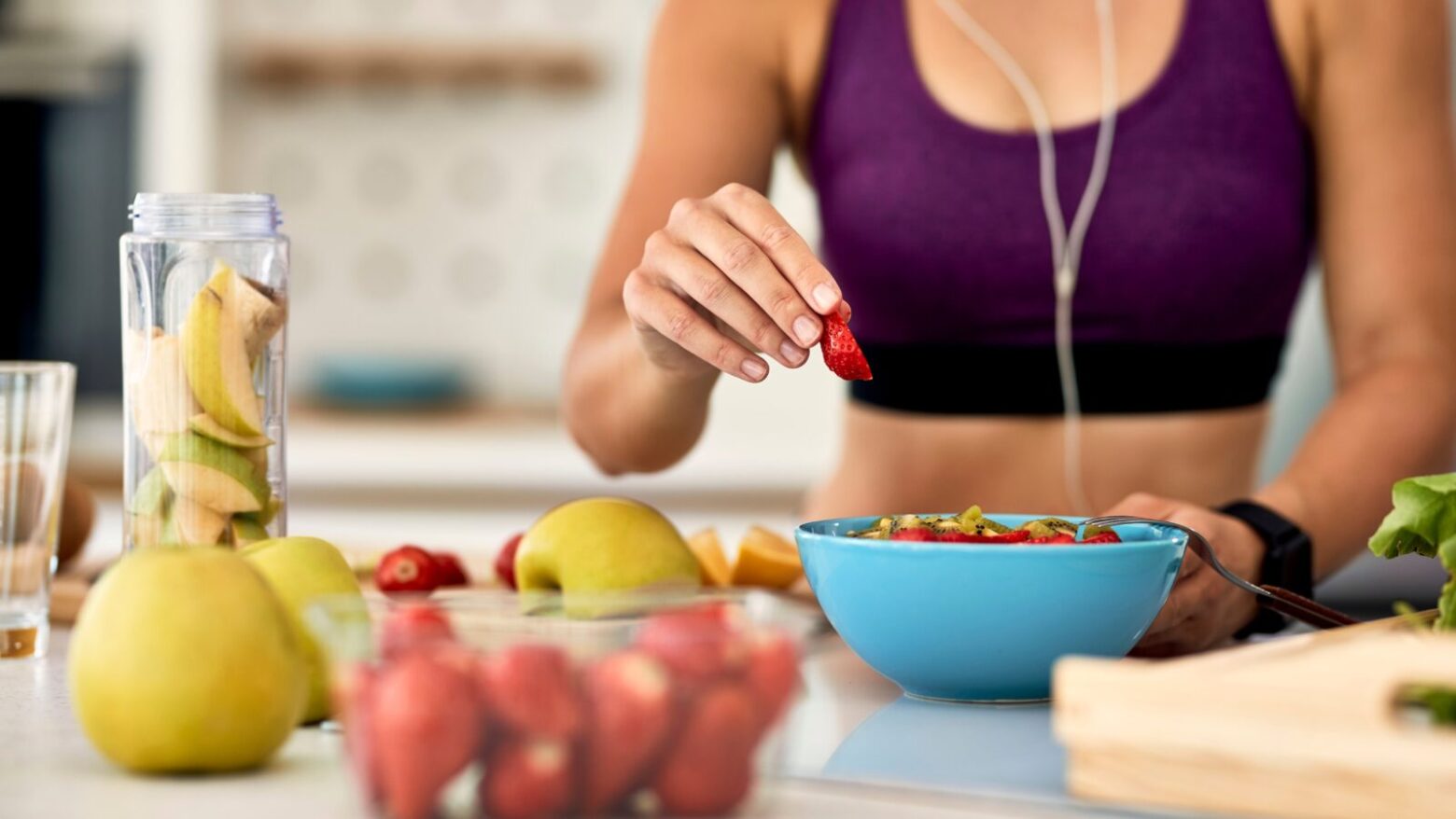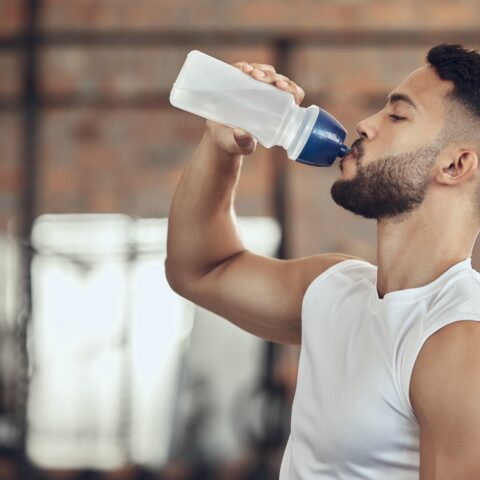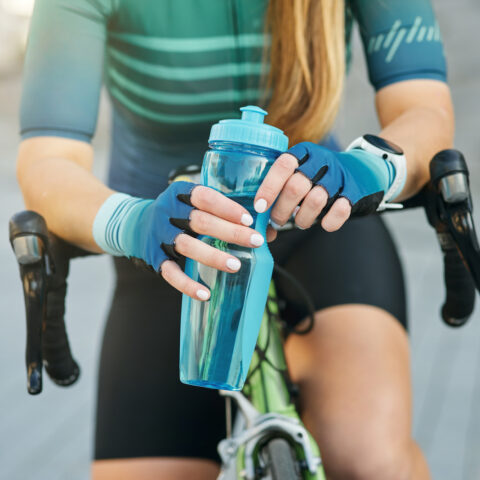Sports Nutrition Basics: Fueling for Exercise

For active people and athletes alike, understanding sports nutrition basics can make a big difference in how you feel, perform, recover, and get stronger. Here’s our primer on carbs, fats, protein, hydration, and nutrition timing.
Sports nutritionist and endurance coach Ryan Kohler offers this review of some introductory concepts. Then we will move into topics that help you think more about your individual needs, and set aside any generalized recommendations that can often do more harm than good.
Fuels for the Human Engine
Let’s imagine the human body as an amazing piece of electrochemical machinery. Our bodies have many inputs and outputs that often operate via electrical signals running throughout the body, chemical messengers communicating between organs, and energy production pathways that power a host of functions like exercise.
So, what are the fuels that help drive the engine? The macronutrients—carbohydrate, protein, and fat—are the three main fuel sources we’ll focus on. One additional nutrient—water—is worth noting: This is the medium within which everything occurs in the body.
Let’s start with a deeper discussion of the most ubiquitous macronutrient in the vocabulary of the endurance world: carbohydrates.
Carbohydrates
Carbohydrates are made up of sugars, starches, and fibers from a variety of foods. Their chemical structure comprises carbon, hydrogen, and oxygen, and therefore you will often see this abbreviated as CHO. (Anytime I write about carbs or reference them with an athlete, I almost always refer to them as “CHO” and it gives an easy way to remember the chemical makeup of this nutrient.)
Within the general classification of CHO, there are four variations: monosaccharides, disaccharides and oligosaccharides, and polysaccharides. While the type does not have a significant impact on the amount of CHO we should consume to fuel our needs, there are quality differences to the type of fuels we ingest.
Monosaccharides
Monosaccharides are the simplest forms of sugar and generally do not occur on their own in nature; rather, they are usually a component of disaccharides and polysaccharides. The three main monosaccharides are glucose, galactose, and fructose. Two of these—glucose and fructose—are the most well-known in the sports world, being the main ingredients in many sports drinks, gels, and other engineered performance fuels. Galactose combined with glucose creates lactose.
Disaccharides and Oligosaccharide
Disaccharides and oligosaccharides are simply a combination of two or more monosaccharides. The most common ones include sucrose (e.g., table sugar, beet sugar, cane sugar), lactose (or milk sugar), and maltose. Oligosaccharides contain between 3-10 sugar molecules and are generally water soluble and sweet at lower linkages. However, they become less digestible as the molecules get larger. These larger molecules are classified as dietary fiber.
Polysaccharides
Polysaccharides contain more than 10 monosaccharide units and are typically stored in plants as starch granules. There are two main structures that plants make with these, and their structure determines their solubility and digestibility.
Functionally, CHOs provide us with energy for movement and maintenance of blood glucose levels. This is done through a molecule called glycogen, often referred to as the storage form of CHO.
There are two main locations where we store CHOs in the body: the liver and the muscles. These stores vary in the amount of glycogen they can hold, so these reservoirs are limited and can affect our performance and recovery if not maintained.
Think of muscle glycogen as your fuel tank for active muscles. So, if you’re pushing hard up a climb and your quads are feeling the heat building up, it’s likely you are tapping into that energy reserve. In the liver, glycogen stores are utilized to maintain high CHO oxidation rates and blood glucose levels, especially in the latter stages of exercise.
Endurance-trained athletes actually perform better because they have improved fat oxidation—something we’ll touch on in part 2—effectively sparing their use of the all-important glycogen molecule.
In the graph below you can see a chart showing CHO and fat oxidation at different intensities of exercise. As intensity increases, we rely more and more on CHO to fuel our exercise and less on fat.

When to Consume Carbohydrates
In future articles we will dig deeper into the details of CHO timing, but at this point the key to remember is that CHOs are necessary for a few key functions around exercise sessions:
Pre-exercise
Pre-exercise CHOs help us to prepare for the work ahead. With a full glycogen fuel tank, we will perform at our best; thus, it is helpful to go into workouts with some CHO on board. Does that mean we should eat bowls of cereal before every ride, or indulge in a huge pasta party before our weekend group ride? No. What we need to understand is that a certain amount of CHO is necessary and beneficial, but there should be a sliding scale for our intake based on our individual needs. (This can be determined in several ways but is outside the scope of this introductory article.)
During Exercise
During long or intensive exercise, CHOs provide the fuel necessary for performance. For short sessions (e.g., less than 90 minutes), CHOs are not critical, but as duration and intensity increase, CHOs become more important.
There’s a saying that sums this up well: “Carbs get you to the finish line.” Can you function without CHOs? Sure, but if you are searching for peak performance or working at a higher intensity, CHOs consistently show performance improvement. There is a sweet spot where CHO ingestion acts in such a way to balance your glycogen losses without tapping too heavily into muscle and liver stores.
Post-exercise
Depending on how long or hard our session was, we may have tapped into a lot of that stored muscle glycogen. With intensive sessions, we need to tune up the amount of CHO coming in. With recovery or light sessions, we don’t have to over-indulge. I normally recommend a snack or “usual” meal following most sessions. It doesn’t have to be anything fancy. Ultimately, think about your post-exercise meal or snack as your first step not only in recovering from the previous session, but also preparing for the next session.
Related: The Endurance Training Dilemma: High Carb vs. Low Carb
Protein
Now let’s look at protein, which isn’t highly effective as a fuel source during exercise. Proteins differ from CHOs in that while they contain carbon, hydrogen, and oxygen, they also contain an important additional element: nitrogen. The nitrogen-containing group (called the amino group) and the acid group help clue us into the name of the building blocks of proteins: amino acids. The make-up of the protein, and ultimately which protein is formed, depends on the arrangement of the hydrogen, amino group, acid group, and side chain (which is unique to each amino acid).
Functionally, proteins participate in structural, transport, and immune functions, and they’re also involved in fluid balance, and hormone and enzyme function. There are both essential and non-essential amino acids, so calories is important to ensure we get those essential amino acids, as these are building blocks that cannot be produced by the body; they can only come from food.
The source of your protein matters, too. In our guide, Plant Protein vs. Animal Protein: What’s the Difference?, we show how it’s possible to consume all the proteins we need from plants but how animal proteins are a much better source in several ways.
Despite the fact that proteins are not utilized as a critical fuel source during exercise (e.g., less than about five percent), athletes should maintain a focus on protein intake due to the functions beyond exercise.
As you can see from the graph above, CHO and fat make up the primary fuel sources. One of the exceptions is during extreme exercise, when fueling is inadequate or the demands of exercise are severe (e.g., ultra-marathons). In cases like that, protein can become an energy source by providing a carbon backbone to generate CHO.
Remember that both CHO and protein have carbon in their structure, and thanks to a process known as gluconeogenesis, our bodies can convert carbon backbones from certain proteins to generate glucose. Take that long word and break it down: Gluco (glucose) – Neo (new) – Genesis (to form). You can see how the terms to describe some of these metabolic processes can give away a lot of information as to the mechanisms going on in the body.
Many exercisers and athletes will consume some protein after a workout as a way to aid muscle protein synthesis (MPS), which is one of the key adaptations following exercise that helps us to recover and become stronger for future exercise. Weight lifters are well known for their post-exercise protein shake, for example. But beware these protein shakes and dietary supplements because they are often made from whey (a dairy byproduct) or legumes like pea or soy proteins, which contain many antinutrients that can be particularly problematic for more serious athletes.
Fat
Finally, let’s look at fats, the final energy source to consider for exercise. Luckily, we have a nearly unlimited reservoir of fat to rely on. Even some of the most elite athletes with very low body fat percentage still have a massive supply on board to power exercise. As we saw above, fat contributes significantly to exercise at low to moderate intensities, and humans are good at burning fat during exercise — and can easily train their bodies to rely more on fat for exercise energy than other fuel sources.
This trainability is also a pretty hot topic in the endurance community as athletes are looking for ways to maximize fat oxidation for performance benefits.
Improving fat oxidation certainly has benefits for endurance athletes as it allows sparing of muscle glycogen and highlights one of the key adaptations for endurance, which is improved mitochondrial density.
The mitochondria are commonly known as the “powerhouses of the cell” where all sorts of reactions take place to generate ATP. ATP is the energy currency in the body: adenosine triphosphate.
This is a substance made up of one compound called adenosine and another made up of three high energy phosphate groups. As the body requires energy, these phosphate bonds are broken and ATP (tri-phosphate), becomes ADP (di-phosphate, two), and finally AMP (mono-phosphate, one) as energy stores deplete. Essentially ATP is our stored energy (like our savings in the bank), and as we need to power exercise, we make withdrawals by breaking those bonds.
Water
The final nutrient of concern is water. While water does not provide any energy, it is a critical piece of the puzzle. As blood transports nutrients, hormones, and other substances throughout the body and removes waste products, water is the primary component of blood.
Achieving fluid balance for athletes is a key factor that can leave you feeling prepared for your session or event—or experiencing a potentially large decline in performance.
When we exercise, we generate heat, and this heat has to leave the body somehow. The blood plays a primary role in this process, so maintaining fluid balance can drastically improve or affect our performance. Some of the key areas where fluid balance can impact us as athletes include:
- Maintaining an appropriate core temperature
- Managing heart rate
- Balancing levels of sodium
- Improving digestibility of fuel
Offloading heat is done by the generation of sweat. As we become dehydrated, either due to inadequate hydration practices and/or continuous exercise in hot weather, that system will be challenged. With a greater heat load on the body through a reduced ability to sweat (and, thus, offload heat), we could see potentially large performance declines.
If you’ve ever fallen behind on your hydration during a workout and then suddenly stopped sweating, that’s a red flag.
As heat stress builds and plasma, or blood, volume, decreases, we see reductions in what is called cardiac output (the amount of blood pumped out per minute) and, simultaneously, our heart rate increases in order to sustain exercise.
At rest, the human body typically has a cardiac output of 5 L/min—every minute we are pumping roughly 5 liters of blood/plasma throughout the body. Heart rate, of course, is how frequently our heart beats per minute (bpm); as heart rate increases, so too does cardiac output. Therefore, generally speaking, maintaining blood volume during exercise will help to offset some of those negative effects.
Another key component to this puzzle is sodium balance. The body normally does a very good job of maintaining this in a tight range. Under normal circumstances we don’t have to think much about this. However, during exercise we can drastically affect these levels under certain conditions.
In hyponatremia, sodium levels in the plasma drop to dangerously low levels. Luckily, it usually takes some work to make this happen in the body. For athletes who are exercising for long periods of time (think 3-4+ hours) and consuming little to no sodium, there is a risk of running into some of the symptoms of hyponatremia. However, if you are consuming sodium and food that contains some salt, your risk of experiencing this becomes very low.
Finally, fluid balance and fluid intake can assist with digestion during exercise. Osmolality describes the amount of solutes dissolved in a solution. When it comes to body hydration, we’re concerned with substances such as sodium and glucose dissolved per liter of fluid.
In the gut, where part of the digestive process takes place, we need to consider how concentrated any given fluid might be. We also need to consider solid fuels and how those might impact digestive ability in a gut with restricted blood flow. Once we start exercising, roughly 80 percent of our blood flow to the gut is redirected to the working muscles—we’ve already started challenging our gut.
This is a topic that can go on for an entire semester, but briefly, keep in mind that many of the engineered sports drinks on the market today have been designed to be close to, or somewhat below, the osmolality of the blood, in order to make absorption easier. Today you’ll see mixtures of 2-4 percent CHO, while some of the mixes from decades ago were in the range of 6-8 percent CHO.
All in all, the same goes for solid foods. The more complex the fuel—the more constituents per liter of fluid—the greater the challenge for digestion.
Daily fluid intake can support exercise hydration. There are many recommendations on how much fluid to drink. Remember the old standby of 8 cups of water per day? That’s one, but what I’ve found successful over the years is to start with a rough recommendation and teach the athlete to monitor their fluid balance.
One of the cheapest and easiest methods to assess your hydration status throughout the day is to look at your urine color. There are medications and foods that can change urine color, but as a starting point, this is a great way to get in tune with your body and note how your habits affect output. Light yellow and transparent is normal and indicates an ideal hydration status.
Fueling Better Can Make a Big Difference
As a nutritionist, I like to focus my work with athletes on their understanding of fueling—not only how it impacts their performance, preparedness, and recovery, but to also dig into their knowledge around sources of these nutrients.
Take student-athletes, for example. I’ve found that, many times, when asked what they consider good fuels for exercise, their list is fairly short and usually contains many of the same sources: cereals/pastas, bars, nuts, and some fruits or juices.
With a busy schedule of school, social commitments, and practices, it can be difficult to access adequate nutrition. Much of the time is spent strategizing ways to increase variety and create opportunities to achieve adequate fueling throughout the day.
When we come to many age-group athletes and experienced athletes, the focus usually shifts to ensuring adequate nutrition to support exercise. One of the main hurdles these athletes run into is focusing too heavily on choosing “healthy” foods while neglecting total energy intake.
This ultimately can lead to low energy and difficulty performing and recovering. Much of the strategy here is to determine which habits work well and maximizing those, adjusting timing around training sessions, and finding additional sources when necessary to optimize energy balance.
Related: The Fundamentals of Sports Nutrition: Assessing the Fueling Station
Ryan Kohler
Ryan Kohler holds a B.S. in exercise science, an M.S. in sports nutrition, and has been published in numerous scientific and popular media outlets.
More About The Author




